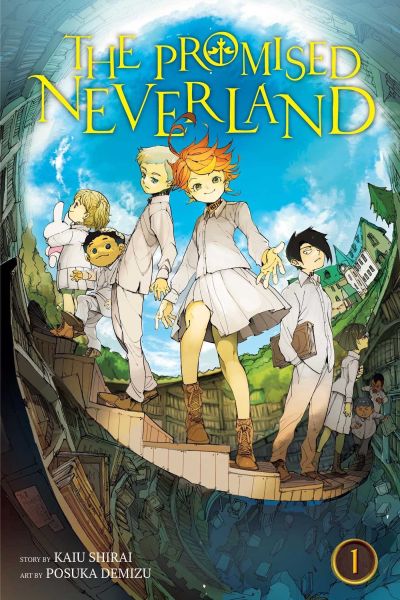Dinner Bell
The Promised Neverland, volume 1
By Kaiu Shira & Posuka Demizu

17 Jul, 2019
The Promised Neverland, Volume 1 collects the first seven issues of author Kaiu Shira and illustrator Posuka Demizu’s manga.
Emma, Norman, and Ray grew up in Grace Field House, an orphanage run by kindly Isabella. Life at Grace Field House is almost luxurious. It is that rare orphanage whose inhabitants would remember it fondly. In later years. If there were later years. To be explained.
Sometime between the ages of six and twelve, the orphans will be fostered out. Emma, Norman, and Ray are the oldest orphans still remaining at the House. Their twelfth birthdays are looming, so they expect that they will soon be sent on their way to new homes.
When fellow orphan Connie forgets her stuffed animal in her haste to leave the House for her new home, Emma and Norman hurry after the six-year-old to return the beloved toy. They find Connie, but not in time.
It seems there is the orphans haven’t been told the truth about their new homes: they have been raised as food for demons.
Emma and Norman manage to return to the House without getting caught but in their haste they leave behind Connie’s stuffed toy. Although the demons who collected Connie for the larder do not understand the significance of the toy, Isabella does: these orphans have seen that which they were never supposed to see until the last moments of their lives.
Emma and Norman have no desire to be food. They must escape. They have a time limit: they will be harvested within two months. The main gate is always locked, so their egress must be found elsewhere. To their alarm, they discover that on the far side of the forest that surrounds the orphanage is a tall wall, far too tall for them to scale without tools.
While the pair are considering their options, they are approached by Ray, who has deduced something is wrong. As soon as he understands the situation, Ray allies with his two friends. He has no more desire to be food than do his friends.
Each of the trio has a key skill: Emma is adaptable, Norman has a superior grasp of tactics, and Ray is a master strategist. Together the trio may be able to find their way over the wall and out into the world. There is, however, a catch: Emma will not abandon the thirty-five other orphans and Norman is too smitten with her to disregard her wishes in this matter. Ray is well aware that shifting the goalposts from saving the trio to saving the orphans means lowering the odds of success from poor to almost certain failure, but he gives in to peer pressure.
Emma, Norman, and Ray set out to deduce what they can about their world, aware that all of the books in the orphanage have selected to present what may be a completely fictitious version of history. As well, they have to work out how to get over the wall, how to bring their fellow orphans with them, and how to do this without Isabella finding out and stopping them. All before their time is up.
It gets worse. Isabella knows full well that some of the orphans have learned their fate and that they must be trying to escape. Isabella tries intimidation: she will reveal to the terrified kids just what resources she has, just how outmatched they are. If they manage to get out, she can track them. She can out-think them. They should just give up and accept being et.
~oOo~
Hey, another work about meddling kids.
Midway through volume one, Isabella imports Sister Krone, another human adult, to help her contain the incipient rebellion. Krone is black. Her features are rather exaggerated. It’s not the worst depiction of a black person in manga by far (manga being all too prone to racist stereotyping) but it’s still jarring. Krone is a devious, ambitious backstabber; she’s as nasty as Isabella. This is a YA that solves the inevitable “but why don’t the kids ask the adults for help?” question by making all available adults part of the problem.
The art in this manga is cloying and twee (at least to my eyes). This might be off-putting in other contexts; in this context, it underlines the horror as Emma and Norman stumble over Connie’s surprised-looking corpse. The contrast between the cute art and terrible reality is, one suspects, part of the point, along with the children’s slow realization that all of the goods in their lives — good food, regular exercise, even their education — are intended to make the children taste better to demons.
Volume one is not intended to stand on its own. Instead, it functions as the introduction to a much longer series. By the end of these first seven episodes, we know the characters and the shape of the trap they are in. Whether they can out-think Isabella, and Krone, and what is outside those tall walls, is left a mystery for future volumes.
This might be just a tad too “horrible things happen to children” for my taste. I’ll give volume two a try but there’s every chance I’ll give this up as too dark for me. Still, don’t let that deter you from trying Promised Neverland.
The Promised Neverland, Volume 1 is available here (Amazon), here (Amazon.ca), and here (Chapters-Indigo).
